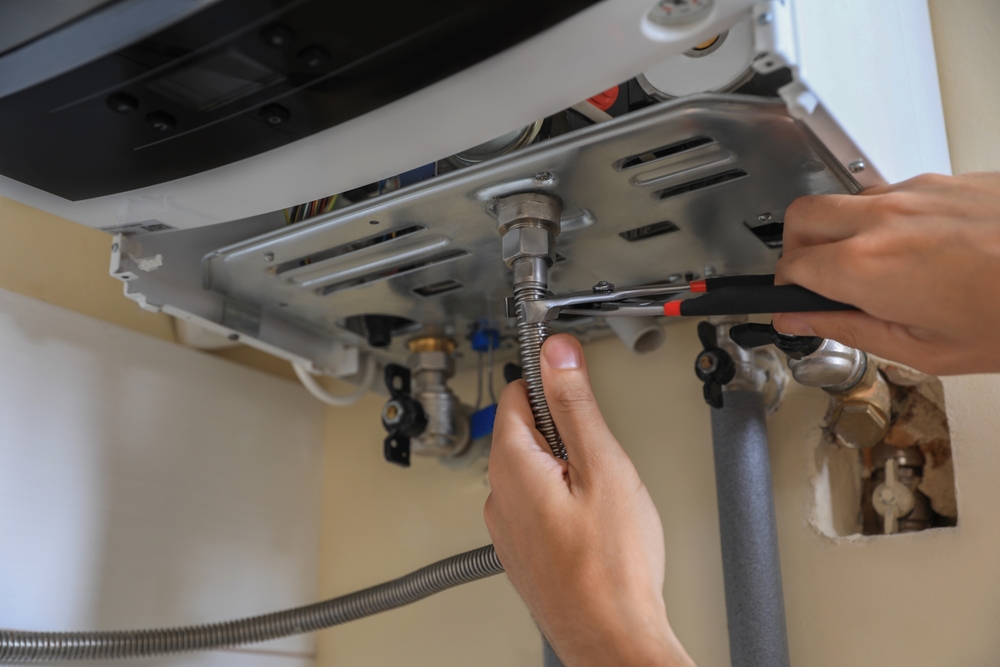At Alpine Home Experts, we know how frustrating it can be to experience heating problems, especially when temperatures drop. That’s why we’ve put together this guide to answer a common question: how long does heating repair take? From boiler heater repair to furnaces, understanding the timeline can help you prepare and minimize disruptions to your day. Let’s break it down.

What Affects Heating Repair Time?
The length of time it takes to complete a heating repair depends on several factors:
Type of Heating System
Different heating systems, such as boiler heaters, heat pumps, and furnaces, have unique designs and repair needs. Here’s what you can expect for each:
Boiler Heater Repair
Boiler heater repair is essential for maintaining warmth during cold months. Repairs often involve fixing leaks, replacing the pilot light, or addressing inconsistent heating. Depending on the complexity, these tasks can take one to four hours. Issues like water pressure problems or significant leaks might require longer repairs or multiple visits. Regular maintenance can help catch minor issues before they escalate into more time-intensive repairs.
Heat Pump Repair
Heat pump repairs, such as addressing refrigerant issues or cleaning coils, usually take between two and four hours. For complex problems, like compressor replacement, the timeline might extend to a full day. Because heat pumps serve dual functions for heating and cooling, their components can be intricate, making proper diagnostics crucial to avoid unnecessary delays.
Furnace Repair
Furnace repairs are often centered around mechanical or electrical components. Common repairs, such as fixing a blower motor or replacing a thermostat, typically take a few hours. However, more significant issues like heat exchanger malfunctions or ductwork problems can significantly extend repair times. Regular inspections and timely filter changes can help reduce the likelihood of extensive repairs.
The Issue’s Complexity
Simple repairs, such as replacing a clogged filter or cleaning a dirty pilot light, can be completed in less than an hour. However, more complicated problems, such as a heat exchanger replacement or significant electrical repairs, may take an entire day or longer.
External Factors Affecting Repair Time
The availability of parts and the time of year can significantly influence repair timelines.
- Parts Availability: While we maintain a stock of common parts to ensure quicker service, specialized components may require additional time to order.
- Seasonal Demand: Boiler heater repair services are in high demand during the winter, which may result in slightly longer repair times despite our commitment to prompt service.
Emergency vs. Scheduled Repairs
Emergency repairs are typically addressed as quickly as possible, often within hours. Scheduled repairs might take longer if additional diagnostics are needed to determine the exact issue.
Typical Heating Repair Timelines
While repair times vary, here’s a general idea of what to expect:
Quick Repairs (Less than 1 Hour):
- Replacing a thermostat
- Relighting a pilot light
- Resetting circuit breakers
Moderate Repairs (1-4 Hours):
- Fixing leaks in a boiler
- Replacing a blower motor
- Cleaning and tuning up the heating system
Extensive Repairs (4+ Hours or Multiple Visits):
- Heat exchanger replacement
- Resolving complex wiring issues
- Repairing significant boiler leaks
How Alpine Home Experts Minimize Repair Time
We’re committed to completing repairs efficiently without sacrificing quality at Alpine Home Experts. Here’s how we ensure your heating system gets back on track quickly:
- Experienced Technicians: Our team has the expertise to diagnose and fix a wide range of heating issues quickly and accurately.
- Comprehensive Diagnostics: We use advanced tools to identify problems efficiently, saving time during the repair process.
- Emergency Services: For urgent heating issues, we’re available 24/7 to restore your home’s comfort as quickly as possible.
- Preparation: Our trucks are stocked with standard replacement parts, so we’re ready to handle most repairs on the first visit.
When to Consider Replacement Instead of Repair
If your heating system frequently needs repairs or is more than 15 years old, it might be time to consider a replacement. New heating systems are more energy-efficient and require less maintenance, saving you time and money in the long run. We’re happy to help you weigh your options and choose the best solution for your home.
Tips to Prevent Lengthy Repairs
Preventative maintenance can reduce the likelihood of significant heating issues and shorten repair times. Here are some tips:
- Schedule Regular Maintenance: Annual tune-ups help identify potential problems early.
- Replace Filters Regularly: Clogged filters strain your system and can lead to breakdowns.
- Monitor Energy Bills: A sudden increase in energy costs might signal an issue that needs attention.
- Listen for Unusual Noises: Strange sounds often indicate mechanical problems that should be addressed promptly.
Heating repair times can vary significantly depending on the type of system, the complexity of the issue, and factors like part availability and seasonal demand. Boiler heaters, heat pumps, and furnaces each have their own repair challenges, from fixing leaks to addressing electrical problems. While some repairs can be completed in under an hour, others may require a full day or more, especially for extensive issues. Regular maintenance and timely attention to minor problems can prevent major disruptions and shorten repair times.
At Alpine Home Experts, we combine experience, advanced tools, and 24/7 availability to restore your home’s comfort as quickly and efficiently as possible. If you’re facing heating issues, don’t hesitate to reach out. Contact us today to schedule a boiler heater repair in Utah or learn more about our services. We’re always here to keep your home warm and comfortable.
